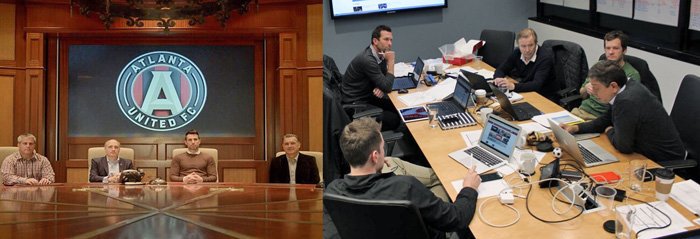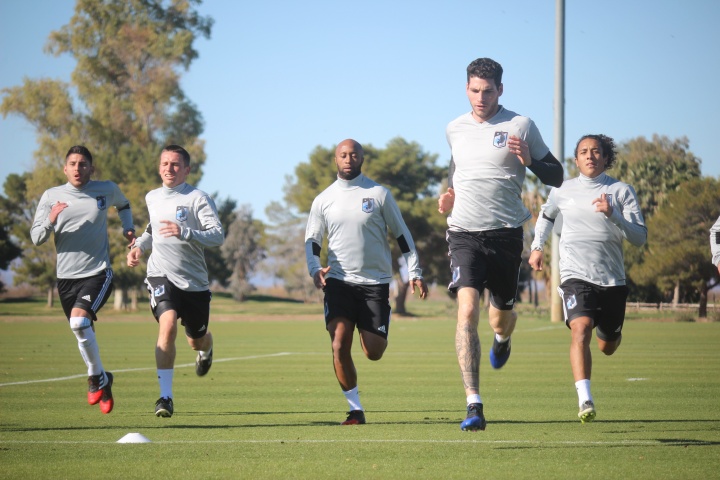By now, seemingly every Minnesota United recruit has been briefed on Grant Wahl’s infamous prediction that the Loons’ over/under for wins this season should be set at five games. It has become an instant rallying point for the team, and Adrian Heath’s boys are dead-set on proving the doubters wrong.
Dogging the Loons has been their expansion foils, the other other United: Atlanta. The two Uniteds’ diametrically opposed approaches were perfectly embodied by the two images that came out of the Expansion Draft in December.

Atlanta beamed out an image of their ashen-faced technical staff seated across a long table in an ornate boardroom. While up in Minnesota, the technical staff was deep in conversation, crammed into a small conference room, with notes, electronics, and spare chairs cluttered everywhere. The contrast—the empire and the rebellion—couldn’t have been more stark.
The squads being assembled by each team are a direct reflection of these approaches. Atlanta has brought in some impressive players, like onetime Arsenal target Miguel Almirón and speedy winger Hector Villalba. These are signings that warrant a twinge of jealousy from every other MLS side.
Minnesota, on the other hand, has signed players with much less flashy pedigrees. Rasmus Schüller, Francisco Calvo, Bashkim Kadrii, and Vadim Demidov may all prove to be inspired finds, but they come from smaller leagues where they played under dimmer spotlights. Likewise, Christian Ramirez and Miguel Ibarra continue to be followed by doubters. Even those of us very familiar with Rambarra’s impressive talents have to admit: the two have yet to prove themselves at this MLS level.
But don’t be drawn too deeply into this duality. This is the key fault that plagues analysis of both expansion teams. Observers habitually assess the two teams side-by-side, and use that comparison to calibrate their predictions. But aside from two of the thirty-four games, what each team does has no bearing on the other’s success. The results of Minnesota and Atlanta are almost entirely independent of each other. It is entirely possible that Atlanta succeed while Minnesota fail, or the inverse. But it’s also quite possible that both teams will fail. Or that both succeed. In order to get a clear-headed picture of the prospects of each team, it’s important not to let the flash of Atlanta alter the assessment of Minnesota, nor the supposed disappointment of Minnesota boost Atlanta’s standing.
“Just give them the cup already…”
Toronto FC fans might do Atlanta a favor and create a twitter bot to remind everyone that “a bloody big deal” doesn’t win you the cup.
While some of Atlanta’s signings have been truly impressive, there tends to be a bizarre refrain that keeps coming from fans and neutral observers alike; that Atlanta is already a title contender. The “just give them the cup already” response seems to ignore the long, long history of MLS clubs splashing cash with little reward. Toronto FC fans might do Atlanta a favor and create a twitter bot to remind everyone that “a bloody big deal” doesn’t win you the cup. NYCFC encountered a similar problem in their first year.
In contrast, the conventional wisdom about Minnesota is that the club has more or less already ceded their first season because it has avoided signing a Designated Player— never mind that D.C. and San Jose also do not have any DPs, or that the Loons have paid down several signings who would ordinarily have counted as DPs. While it is true that the Minnesota technical staff haven’t prioritized a game-breaking player like Sebastian Giovinco or Nico Lodeiro, that doesn’t foreclose the possibility that Minnesota can put together a respectable team.
In interview after interview, Adrian Heath emphasizes that Minnesota’s recruitment strategy is finding players “who want to be here.” Perhaps the taste of Orlando City sticks in Heath’s mouth, where, according to some, a phone call came down every time Kaká was benched. The club Heath wants to build in Minnesota is centered around a solid squad of players who can achieve together.
One needs only look at the 2016 Colorado Rapids to understand that this approach can be just as successful as one based on flashy signings, à la NYCFC or Toronto FC. The Rapids’ Eric Miller was a recent guest on the FiftyFive.One podcast and spoke specifically about how Colorado’s success was tied to chemistry. The Rapids, who were the consensus worst team in MLS heading into the 2016 season, ended up nearly winning the Supporters Shield. As Miller pointed out, most MLS teams, top to bottom, have a similar level of talent on their rosters, which is why a team like FC Dallas can suffer a 5-0 thrashing at the hands of Houston Dynamo on any given day. What matters in the long term is the group’s commitment and trust in each other. That’s something that can’t be bought.
Chemistry
Now, just because it’s possible for a smaller budget team to succeed doesn’t mean it actually will. The Loons have a clear blueprint, but executing it is a separate task.
The question still remains as to whether Minnesota United can actually achieve the hard-scrabbling chemistry required to overcome its obvious lack of sizzle and spark. For all the 2016 Colorado Rapids, there are also 2016 Chicago Fires or Houston Dynamos.
Additionally, as FourFourTwo’s Paul Tenorio points out, Minnesota has a surprising lack of MLS experience on its roster. Only four players on the roster have more than 50 MLS games under their respective belts.
FWIW MNUFC: 8 MLS vets, 498 gms, 4 players >50 gms; ATLUTD: 9 MLS vets, 1079 gms, 4 players >180 gms
— Paul Tenorio (@PaulTenorio) January 26, 2017
The Loons do have a core group of players returning from their NASL roster, which may instill confidence or doubt, depending upon one’s perspective. Ibarra and Ramirez will have a built-in chemistry that cannot be overstated—the two average several no-look backheels a minute when combining together. But all of the players continuing on with the club (Ibson, Ramirez, Kallman, K. Venegas, Davis, Añor, and Ibarra) also played for an under-performing NASL squad, and there is a legitimate concern these players may continue to play to an NASL standard, rather than rise to that of MLS.
All of this is to say that Minnesota may struggle in 2017; they have a good number of obstacles to proving themselves, and there’s no sense in delusion. But if Loons players can work together to meet expectations—if, for example, Ramirez can prove even half as deadly in front of goal in MLS as he was in the NASL—then there is absolutely no reason that they can’t put together a respectable 2017 campaign.
Conversely, there’s no guarantee of success for Atlanta United. The A’s have plenty of questions as well. Their depth behind striker Kenwyne Jones is deeply suspect. Their possible starting #10 is a player who was so hated at his former club that fans greeted his loan with epithets and death threats. They will not have Brad Guzan until the summer. Spending money cannot erase the unknowns intrinsic to expansion teams.
A push for the playoffs for Minnesota or a collapse of Atlanta are not impossibilities. In fact, anyone who says they know what will happen is willfully neglecting the history of parity in MLS. But all of this—the debates, the doubting, the gnashing of teeth — is precisely why we watch soccer. “Einsteins,” as José Mourinho calls them, make prognostications and teams prove them to be either geniuses or ignoramuses. And only hindsight can separate the incisive analysis from the irrelevant distractions.

Leave a Reply